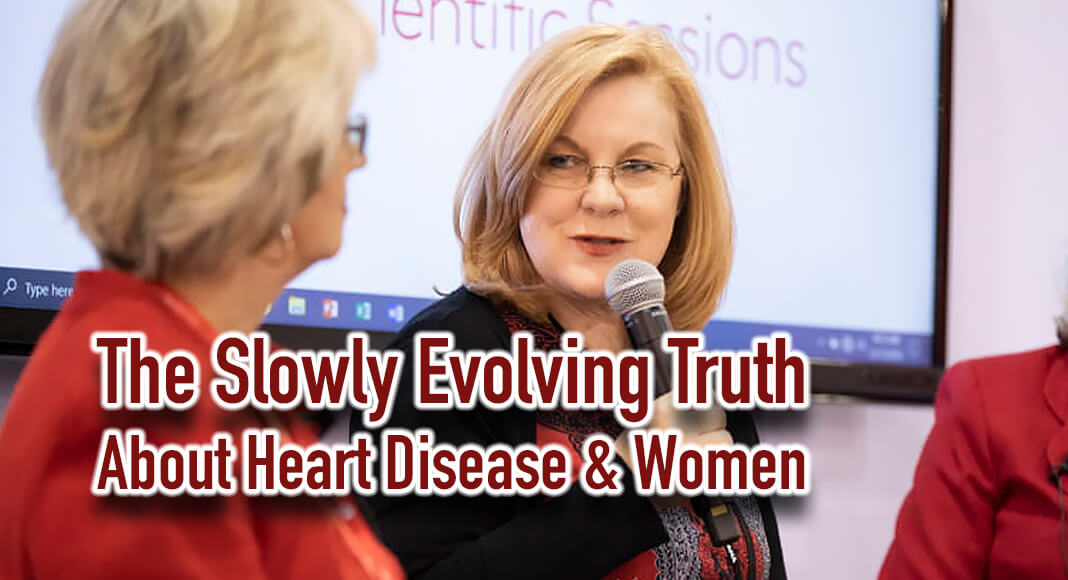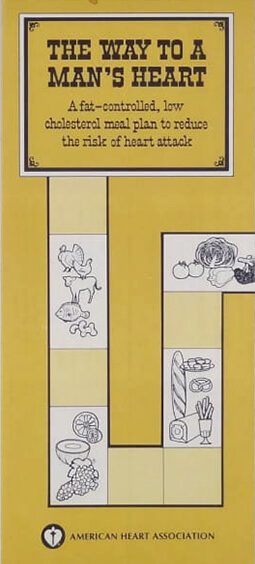
Mega Doctor News
By Laura Williamson, American Heart Association News
A century ago, so little was known about heart disease that people who had it resigned themselves to years of bed rest or, worse, an early death. Even less was known about how heart disease affected women – because nobody thought it did.
Heart disease was considered a man’s disease. If women had a role to play, it was in taking care of the men in their lives. Even the American Heart Association hosted a conference in the 1960s themed “How Can I Help My Husband Cope with Heart Disease?” and published a nutrition pamphlet titled “The Way to a Man’s Heart.”

That attitude persisted throughout the 20th century, a time when questions about a woman’s health were centered on the parts of her body under her bikini, said Dr. Gina Lundberg, clinical director of the Emory Woman’s Heart Center and a professor at Emory University School of Medicine in Atlanta.
“It was, ‘Get a pap smear and a mammogram and you’re good,'” she said. “We left out all the things we were checking men for, like diabetes and cardiovascular disease. But between a woman’s breasts and her reproductive organs is her heart.”
Women were believed to have some natural protection from heart disease until their hormone levels dropped during menopause, Lundberg said. After menopause, it was believed that hormone replacement therapy could prolong that protection, a premise since amended to apply only to women who take it during the early stages of this transition.
It wasn’t until the turn of the century neared that evidence began to slowly emerge that women, as well as men, faced a substantial risk from heart disease, beginning at a much earlier stage in life and with sometimes differing symptoms than men.
Left out of the research
It wasn’t until the mid-1980s when anyone began looking at how heart disease might affect women.
That’s when the Framingham Heart Study, the first in-depth, long-term cardiovascular investigation in the U.S., began reporting sex-specific patterns of heart disease, questioning whether the magnitude of this condition in women was being overlooked. The researchers noted that heart attacks were less likely to be recognized in women than in men.
They also pointed out that prior investigations had failed to adequately assess sex differences in heart disease because an insufficient number of women were included in the research. Since heart disease was thought to predominantly affect men, only men were being studied.
This started to change in the 1990s, after Atlanta cardiologist Dr. Nanette Wenger and others led a push for the equitable inclusion of women in National Institutes of Health-funded research. Doing so became NIH policy in 1989 and was written into law in 1993. But Wenger later said the legislation amounted to little more than a directive, falling short of achieving parity. “It had no teeth,” she recently told The Fuller Project.
Meanwhile, the prevention and treatment of heart disease in women was based on evidence that came from studies of predominantly middle-aged men, said Dr. Jennifer Mieres, a professor of cardiology and associate dean for faculty affairs at the Zucker School of Medicine at Hofstra/Northwell in Hempstead, New York.
“We thought that you could treat men and women the same,” said Mieres, who was the first woman to be a full-time faculty cardiologist at Northwell Health’s North Shore University Hospital. “We had great advances in treatment strategies, but we were applying a one-size-fits-all approach and clearly that wasn’t working.”
A landmark 2001 report from the Institute of Medicine, a nonprofit policy research organization now known as the National Academy of Medicine, highlighted the underrepresentation of women in clinical trials and sex biases in medicine, calling for a better understanding of differences in how men and women were affected by disease.
Mieres said women often failed to meet the criteria for clinical trials because their signs and symptoms didn’t match assumptions about what constituted cardiovascular risk. “Our research criteria were customized to men as the gold standard.”
This realization led to a push for sex-specific clinical trials, allowing researchers to focus exclusively on how cardiovascular disease develops in women, she said. And that led to the discovery that heart disease caused by narrowed heart arteries is more complex and behaves differently in women than in men.
Beyond the bikini: A new picture of women’s health
One of the biggest questions driving the push for more research was why, despite developing heart disease about 10 years later than men, more women were dying from it. And why were women under 65 twice as likely to die from a heart attack as their male peers?
As researchers began to dig, a new picture of women’s health emerged.
One problem was health care professionals were doing less to protect women from heart disease, according to a 1999 report from the AHA and American College of Cardiology, the first women-specific clinical recommendations for the prevention of heart disease.
For example, women were less likely to be counseled by health care professionals to reduce their cardiovascular risk factors, such as by losing weight, eating a healthier diet or becoming more physically active. They also were less likely than men to be referred to cardiac rehabilitation following a heart attack or bypass surgery.
Mieres said it became clear that women needed better information so they could take control of their own health decisions. So, the AHA established Go Red for Women, a national campaign to raise awareness of heart disease and stroke as leading killers of women and to advance the science of sex differences in heart disease. It also joined forces with the National Heart, Lung, and Blood Institute, which was developing its own campaign, The Heart Truth. The two campaigns were launched back-to-back in 2003 and 2004.
The Heart Truth went first, unveiling the Red Dress as the national symbol for women and heart disease. That same year, the cover of Time magazine told women they were wrong to think breast cancer was their biggest worry and proclaimed, “ONE OUT OF THREE women will die of heart disease.”
A year later, the AHA launched Go Red for Women, along with women-specific, evidence-based heart disease prevention guidelines. The report emphasized that despite significant gains in the treatment of heart disease, it remained the leading killer of women in the U.S.
Mieres, a member of AHA’s national board of directors during Go Red’s formative years, said the idea for a media campaign was heavily influenced by an AHA-sponsored survey showing women were more likely to turn to media sources than their doctors for health information.
“To me, that was an ‘aha’ moment,” she said. “That’s when we realized the way to get accurate science out to women and encourage women to become heart health literate was through these partnerships that could provide the tools and information needed to truly begin the journey of heart-healthy living. We used the power of storytelling. We produced public service announcements and documentaries. We wanted women to know that heart disease could be prevented by making lifestyle changes.”

And for a while, it worked. The number of women recognizing heart disease as a major health risk nearly doubled, from 7% in 1997 to 13% in 2003. By 2009, 65% of women understood heart disease was their leading cause of death. Mortality from cardiovascular disease began to decline in women, though at a slower rate than it did in men.
But those gains did not last. By 2019, only 44% of women recognized heart disease as their No. 1 killer, and a majority failed to recognize the signs and symptoms of a heart attack. Young women and Hispanic and Black women experienced the greatest drop in awareness.
Among health care professionals, Lundberg said awareness of how big a risk heart disease is for women remains poor, even a decade after a survey found weight issues and breast health ranked higher than heart health when primary care physicians were asked about their level of concern for various health issues in their patients.
And a staggering 70% of physician trainees report they aren’t getting enough, if any, education in gender-based medical concepts during postgraduate medical training. In a nationwide survey, only 22% of primary care doctors and 42% of cardiologists said they feel extremely well prepared to assess cardiovascular risks in women.
“We are lagging in implementing risk prevention guidelines for women,” Lundberg said. “A lot of women are being told to just watch their cholesterol levels and see their doctor in a year. That’s a year of delayed care.”
It may be costing women their lives.
Heart attack hospitalization rates among women under 55 have increased, as rates among men of the same age have dropped, one study found. And recent studies show women are more likely to die after having heart attack.
Research shows women continue to be undertreated for cardiovascular problems compared to men. They are less likely to be treated for high cholesterol with statins, which have been shown to lower the risk for heart attacks and strokes. They also are less likely than men to be prescribed blood-thinning drugs to prevent or treat blood clots as treatment for atrial fibrillation, or AFib.
“Statins have helped us make huge improvements in cardiovascular health, but women still aren’t getting all the benefit,” Lundberg said.
Although they are more likely to have heart failure, women also are substantially less likelythan men to receive lifesaving treatments for it, including heart transplants. They are less likely to receive guideline-directed treatment after a heart attack or unstable angina, or to receive treatment in a timely fashion. They are less likely to undergo procedures to restore blood flow to the heart, such as bypass surgery or inserting stents to open blocked arteries.
Unique risks to women’s heart health
While gains in awareness may have backslid, progress toward understanding the unique cardiovascular risks women face has surged in recent decades.
Over the past 20 years, there have been significant strides in showing how menopause contributes to heart health. For example, menopause symptoms such as hot flashes and night sweats have been linked to an increased risk for high blood pressure, a major risk factor for cardiovascular disease.
One of the biggest discoveries of the past decade has been the link between pregnancy complications and heart disease and stroke risk, Lundberg said.
“Now we know that if a woman has gestational diabetes, hypertension, preeclampsia or eclampsia, they are at increased risk for cardiovascular disease later in life,” she said.
Research has also shown that having high blood pressure before becoming pregnant might double a woman’s risk of developing cardiovascular disease within a decade of giving birth.
Other sex-specific risk factors that have come to light include starting menopause before age 40 and having endometriosis or polycystic ovary syndrome, a hormonal disorder that affects the ovaries. Women also are more likely to have autoimmune disorders, such as rheumatoid arthritis or lupus, that cause plaque to build up faster in their arteries and lead to worse outcomes following a heart attack or stroke.
As for better understanding differences in the ways heart disease develops in men and women, it’s now known that atherosclerosis – the buildup of plaque in the arteries that leads to heart attacks and strokes – differs in the size of the plaque, where it is found and how vulnerable it may be to rupture. Women are more likely than men to have a heart attack caused by plaque erosion, spontaneous coronary artery dissection and problems other than an obstruction, while men are more likely to have heart attacks caused by rupturing plaque in their arteries.
What we still don’t know
Many knowledge gaps remain, Lundberg said, especially in the ways heart disease disproportionately affects women from different racial and ethnic groups. Compared to other women in the U.S., Black women have the highest rates of high blood pressure, stroke, heart failure and coronary artery disease. They also have been less likely to be included in clinical studies.
A growing body of evidence suggests structural racism and other social determinants of health play a role, such as having less access to health care services and healthy foods or challenges created by language barriers and acculturation. Many of these conditions likely add to their stress, Lundberg said, which in turn can contribute to higher cardiovascular risks.
“We know that stressful things in these women’s lives cause heart disease, but we don’t know exactly how or how to prevent it,” she said.
Too few women in cardiology
One of the biggest problems for women with heart disease can be finding a doctor who will understand what they’re going through, said Lundberg, who also chairs the Women in Cardiology section of the American College of Cardiology.
“There are not enough women and especially not enough women of color who are entering the field of cardiology,” she said. “If you’re a male taking care of a female, you may have a bias that women are more dramatic about pain or don’t have as big a heart problem. But if you are a woman taking care of a woman, you may listen differently.”
The entire medical community, including the AHA and ACC, have been pushing to expand the medical workforce to include more women, especially those from diverse racial and ethnic backgrounds, Mieres said.
“The medical workforce should reflect the diverse population being served,” she said. “If a medical team member looks like the person they are treating, there’s more trust. The patient will share more and is more likely to stick to a treatment plan.”
Change takes time, so start early
Mieres said she’s convinced the only way to make lasting changes to women’s heart health is to promote good habits – including regular physical activity and the importance of eating a healthy diet – much earlier in life.
“People need to be better educated about health in general,” she said. “I’m a big believer that it should start in kindergarten.”
If nothing else has been learned over the past century, it’s that change may take time, but it’s possible, Mieres said.
“It has been a slow evolution,” she said. “And we need to do more.”








